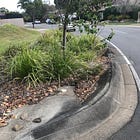Connecting ideas on the verge
Our streets bring everything crashing together - different disciplines, different sectors, competing and complementary uses. Streets connect us all. They are places of friction and opportunity.
What an interesting group, and wide-ranging conversations, we had at our verge visit on Sunday. It was a bright, sunny end to a Brisbane winter - warm enough for the effect of shade to be noticeable.

Innovation for Resilience
Evelyn Liew and Anjalee Panditha, finalists in the National Disaster Challenge 2025, came to see a practical implementation of a verge garden designed as part of the public space.
Their idea, From verge to vital: People-powered green spaces for climate and disaster resilience, is about transforming underused public spaces into smart, nature-based infrastructure that reduces disaster risks like floods and fires. Along with their colleague, Sebastian Bernal Garcia, they each bring their different disciplinary knowledge and approaches to their proposal.
Trees and the Urban Forest
Lyndal Plant, Urban Forester, and Chair of TREENET, came with a wealth of knowledge.
She saw how my street tree is thriving in its native verge garden compared to the street tree merely surviving in grass next door. We also looked at the larger street tree of the neighbour on the other side. Its roots have been scalped by mowers for much of its life but are now protected by a small verge garden.
Designing out a problem can be a better strategy than trying to fix it.
TREENET’s 2025 National Street Tree Symposium is this week, 4th and 5th September, in Adelaide. Find out more here.
TREENET’s annual symposium is a high point in the Australian community urban forestry calendar. Every September practitioners from government, commercial and non-profit sectors share new knowledge and are inspired in all facets of arboriculture and urban forestry.
Garden Design
Tanya Gómez, Horticulturalist and advocate for biodiversity, and Ashley Nicholson, Gentle by Nature Landscape Design, who both have practical experience creating verge gardens, added another dimension to the conversations.
Walk and Talk
We walked down the hill, through a world of grass verges, to the raingarden at the bottom. We talked about different models of governance needed for verge gardens, bushcare and catchment groups, and the raingarden which is part of the stormwater system.
We carried on to the creek where that stormwater ends up, platypus habitat, and the site of the local bushcare group. This site floods regularly which makes me wonder about the connections between the resilience project idea and the recent research on how our cities might deal with flood buy-back properties. (See Saturation point: Parks as water infrastructure and the research behind it.)
On the way, we saw a non-compliant verge garden with rocks (trip hazards) that feels like it is encroaching on the public space. It makes you feel more like you are walking through someone’s garden compared to the low-key, “this is public space” approach that I aim for.
On the way back, we noted another verge planting that would send exotic weed seeds down with the stormwater to that bushcare site and the creek.
Conversations
There was a lot more, and many side conversations along the way. Who knows where those conversations will lead.
The verge offers us this unusual space that brings all sorts of people together, and everyone’s contribution matters. Could we have assembled such a group without the place and topic that brought us together?



